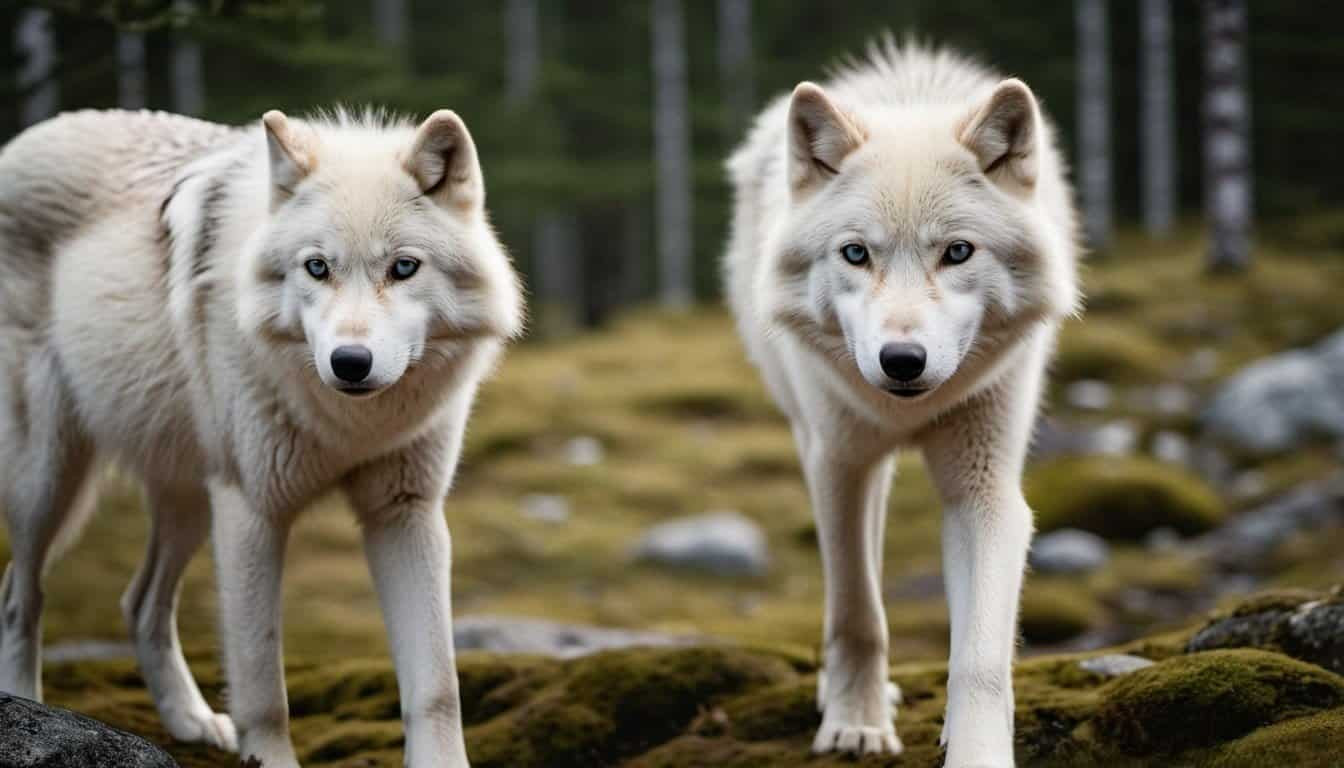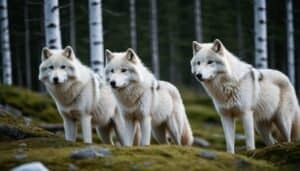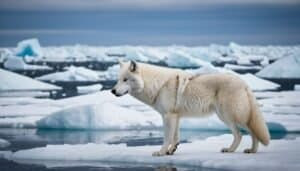Introduction
Protecting the Arctic wolf requires a multifaceted approach involving various conservation measures. This article delves into the main threats to the Arctic wolf, the role of protected areas, and the organizations dedicated to its conservation
We’ll explore the legal frameworks, both national and international, that safeguard this species, and examine how climate change affects their habitat. Additionally, we’ll highlight the crucial role local communities play in conservation efforts and the importance of ongoing research and monitoring to ensure the survival of the Arctic wolf
Overview of Arctic Wolf Protection
Protecting the Arctic wolf, a resilient yet vulnerable species, requires a comprehensive strategy addressing multiple factors
The Arctic wolf (Canis lupus arctos), native to the Arctic regions of North America and Greenland, faces unique challenges due to its harsh habitat and the increasing pressures of human activity and climate change
Main Threats to the Arctic Wolf
The Arctic wolf’s primary threats include climate change, habitat loss, and human activity. Climate change significantly impacts the Arctic ecosystem, leading to melting ice, altering prey availability, and changing vegetation patterns. These environmental shifts can disrupt the delicate balance of the Arctic food web, affecting the wolves’ primary food sources like caribou and Arctic hares
Human activities, such as oil and gas exploration, mining, and increased Arctic shipping traffic, also pose significant risks. These activities can lead to habitat destruction, pollution, and increased human-wolf conflicts
Furthermore, the expansion of human settlements and infrastructure development in previously remote areas can fragment the wolves’ habitat, limiting their range and reducing their ability to hunt and reproduce effectively
Importance of Protected Areas
Protected areas play a crucial role in Arctic wolf conservation. Establishing national parks, wildlife reserves, and conservation areas helps preserve critical habitats and provides a refuge from human encroachment
These protected regions offer a safe haven where wolves can hunt, breed, and thrive without the immediate threat of habitat destruction or human interference
For example, Canada’s national parks in the Arctic, such as Auyuittuq National Park and Quttinirpaaq National Park, encompass vast tracts of wilderness that are crucial for the survival of Arctic wolves
These parks not only safeguard the wolves’ natural habitat but also serve as research sites for scientists studying the species and its ecosystem
Organizations Involved in Conservation
Several organizations are dedicated to the protection and conservation of the Arctic wolf. These include government agencies, non-profit organizations, and international coalitions working together to ensure the species’ survival
Notable organizations include the World Wildlife Fund (WWF), which focuses on protecting Arctic ecosystems and advocating for policies that mitigate climate change impacts
The International Union for Conservation of Nature (IUCN) also plays a vital role in Arctic wolf conservation by monitoring populations, assessing threats, and promoting conservation actions. Additionally, regional organizations like the Arctic Council facilitate cooperation among Arctic nations to address environmental and wildlife conservation issues collectively
National Laws Protecting the Arctic Wolf
National laws and regulations are essential in safeguarding the Arctic wolf. In Canada, the Species at Risk Act (SARA) provides legal protection for endangered and threatened species, including the Arctic wolf
This legislation mandates the development of recovery plans and critical habitat protection measures to support the conservation of listed species
Similarly, the United States’ Endangered Species Act (ESA) offers protection to wolves and other wildlife by prohibiting activities that harm or kill listed species. These laws enable governments to enforce conservation measures, allocate resources for research and habitat protection, and penalize illegal activities that threaten wildlife
International Agreements and Cooperation
International agreements and cooperation are crucial for the effective protection of the Arctic wolf, given their transboundary habitat
The Convention on International Trade in Endangered Species of Wild Fauna and Flora (CITES) regulates the international trade of endangered species, including the Arctic wolf, ensuring that trade does not threaten their survival
The Arctic Council, an intergovernmental forum comprising Arctic nations, promotes sustainable development and environmental protection in the Arctic. Through collaborative initiatives and research programs, member countries work together to address the challenges facing Arctic wildlife, including the Arctic wolf
Climate Change and Its Effects
Climate change poses one of the most significant threats to the Arctic wolf. The rapid warming of the Arctic region is causing profound changes in the environment, which directly and indirectly affect the wolves and their ecosystem
Understanding these impacts and implementing adaptive conservation measures are crucial for the survival of the Arctic wolf
Impact of Climate Change on Arctic Wolf Habitat
The Arctic is warming at a rate nearly twice the global average, leading to a cascade of environmental changes. One of the most visible impacts is the melting of sea ice, which reduces the habitat available for the wolves’ prey, such as seals
As sea ice diminishes, the availability and distribution of prey shift, forcing wolves to adapt their hunting strategies and travel greater distances to find food
Additionally, the thawing of permafrost affects the vegetation patterns in the Arctic. Changes in plant communities can alter the abundance and distribution of herbivores like caribou and muskox, which are primary food sources for Arctic wolves. As these prey species move or decline, wolves may struggle to find sufficient nutrition, leading to potential decreases in wolf populations
Climate change also exacerbates extreme weather events, such as severe storms and prolonged periods of unseasonable warmth or cold. These events can disrupt the wolves’ ability to hunt and breed successfully, further stressing the population
Adaptive Measures for Conservation
To mitigate the effects of climate change on the Arctic wolf, conservationists are implementing several adaptive measures
One critical approach is enhancing habitat connectivity. By ensuring that protected areas are linked, wolves can move more freely across the landscape in search of food and mates, reducing the impact of habitat fragmentation
Another adaptive measure involves monitoring and managing prey populations. Conservationists track the abundance and distribution of key prey species to anticipate and respond to changes that might affect the wolves. This monitoring helps inform management strategies, such as adjusting hunting regulations for prey species to ensure their populations remain robust enough to support predators like the Arctic wolf
Efforts are also being made to reduce human-induced stressors. For example, minimizing industrial activities in critical wolf habitats and implementing stringent regulations on oil and gas exploration can help preserve the natural environment. Reducing pollution and protecting the integrity of the ecosystem are vital for the overall health of the Arctic region
Furthermore, international collaboration is essential for addressing climate change impacts on Arctic wolves. Countries within the Arctic Council are working together to develop and implement comprehensive climate action plans that consider the needs of wildlife
These plans include initiatives to reduce greenhouse gas emissions, promote sustainable development, and enhance scientific research on climate impacts
Research plays a crucial role in adaptive conservation. Scientists are conducting studies to understand the specific ways climate change affects Arctic wolves and their prey. This research provides valuable data that can inform conservation strategies and policy decisions
By staying informed about the latest scientific findings, conservationists can adapt their approaches to ensure they are effectively addressing the challenges posed by a changing climate
Role of Local Communities
Local communities play a pivotal role in the conservation of the Arctic wolf. Their involvement and cooperation are essential for the successful implementation of conservation strategies, as they often have a deep understanding of the local environment and the species that inhabit it
Engaging communities in conservation efforts helps ensure the protection of the Arctic wolf and fosters sustainable practices that benefit both wildlife and human populations
Community Engagement in Conservation Efforts
Community engagement in Arctic wolf conservation involves various activities, including education, awareness campaigns, and direct participation in conservation projects
Educating local residents about the importance of the Arctic wolf and the threats it faces is crucial for garnering support for conservation initiatives. Schools, community centers, and local media can be effective platforms for spreading awareness and fostering a sense of stewardship among residents
Involving community members in monitoring and research activities is another way to engage them in conservation efforts
Citizen science programs, where local volunteers assist scientists in collecting data on wolf populations and behavior, can provide valuable information while also empowering residents to take an active role in conservation. These programs also help build trust and cooperation between scientists and local communities
Additionally, community-led conservation projects, such as habitat restoration and anti-poaching patrols, can significantly contribute to the protection of the Arctic wolf. These initiatives benefit from local knowledge and expertise, ensuring that conservation measures are culturally appropriate and effective
Success Stories from Local Initiatives
Several success stories highlight the positive impact of community involvement in Arctic wolf conservation. For instance, in certain parts of Canada, Indigenous communities have taken the lead in protecting wildlife, including Arctic wolves, through traditional land management practices and modern conservation techniques
In the Northwest Territories, the Dene and Inuvialuit peoples have established community-driven conservation areas that protect critical habitats for Arctic wolves and other species
These areas are managed using a combination of traditional ecological knowledge and scientific research, ensuring that conservation practices are both effective and respectful of Indigenous cultures
Another successful initiative is the Arctic Borderlands Ecological Knowledge Cooperative, which involves local communities in monitoring environmental changes and wildlife populations, including Arctic wolves
This cooperative collects data from Indigenous hunters and trappers, combining it with scientific research to create a comprehensive understanding of the Arctic ecosystem. The insights gained from this collaboration help inform conservation strategies and policy decisions
Furthermore, eco-tourism ventures led by local communities can provide economic incentives for conservation. By offering guided wildlife tours that showcase Arctic wolves and other unique species, communities can generate income while promoting the protection of their natural heritage
These ventures not only raise awareness about the importance of conservation but also demonstrate the potential for sustainable economic development that benefits both people and wildlife
Research and Monitoring
Research and monitoring are fundamental components of Arctic wolf conservation. Through scientific studies and continuous observation, conservationists can gather crucial data on the wolves’ behavior, population dynamics, and habitat requirements
This information is essential for developing effective conservation strategies and ensuring the long-term survival of the species
Techniques for Studying Arctic Wolves
Several techniques are employed to study Arctic wolves and gain insights into their ecology and behavior. One common method is radio collaring, where wolves are fitted with GPS collars that track their movements
This technology allows researchers to monitor the wolves’ range, migration patterns, and interactions with other wildlife. The data collected from radio collars can reveal critical information about the wolves’ habitat use, hunting strategies, and social structure
Camera trapping is another valuable technique used in Arctic wolf research. Motion-activated cameras are strategically placed in the wolves’ habitat to capture images and videos of their activities
These cameras provide visual records of the wolves’ behavior, pack dynamics, and the presence of other wildlife. Camera trapping is particularly useful in remote and inaccessible areas where direct observation is challenging
Genetic analysis is also an important tool in studying Arctic wolves. By collecting and analyzing DNA samples from wolf scat, hair, or tissue, scientists can assess genetic diversity, population structure, and relatedness among individuals
Genetic studies help identify distinct populations, track changes in genetic health over time, and inform conservation planning
Additionally, researchers conduct field observations to study the wolves’ behavior and interactions in their natural habitat. Field studies often involve tracking wolf packs, recording their hunting and feeding habits, and observing their interactions with other species
These observations provide valuable context for understanding the ecological role of Arctic wolves and the challenges they face
Importance of Data in Conservation Strategies
The data collected through research and monitoring are vital for informing and guiding conservation strategies. Accurate and up-to-date information on Arctic wolf populations and their habitat requirements enables conservationists to identify critical areas for protection and prioritize conservation actions
Population monitoring helps detect trends in wolf numbers and distribution, allowing conservationists to assess the effectiveness of existing protection measures and adapt strategies as needed. For example, if monitoring data indicate a decline in wolf populations, conservationists can investigate potential causes, such as habitat degradation or prey shortages, and implement targeted interventions to address these issues
Data on habitat use and movement patterns are crucial for designing protected areas and wildlife corridors that accommodate the wolves’ spatial needs. By understanding where wolves travel, hunt, and breed, conservationists can ensure that these vital areas are included in conservation planning and protected from human encroachment
Research on the wolves’ diet and prey preferences provides insights into the health of the broader ecosystem. Changes in prey availability or the introduction of new prey species can have significant implications for wolf populations. By monitoring these factors, conservationists can anticipate and mitigate potential impacts on the wolves
Furthermore, genetic data help maintain the genetic health and diversity of Arctic wolf populations. Conservation strategies can incorporate measures to prevent inbreeding and promote gene flow between isolated populations, enhancing the wolves’ resilience to environmental changes and diseases
Involving local communities in research and monitoring efforts also enhances conservation outcomes. Community-based monitoring programs empower residents to contribute to scientific knowledge and conservation actions, fostering a sense of ownership and responsibility for wildlife protection
Overall, research and monitoring provide the scientific foundation for effective Arctic wolf conservation. By continuously gathering and analyzing data, conservationists can make informed decisions, adapt to changing conditions, and ensure the long-term survival of this iconic species
Conclusion
Protecting the Arctic wolf requires a comprehensive and collaborative approach that addresses various challenges posed by environmental changes and human activities
Conservation efforts encompass understanding the main threats to the Arctic wolf, such as climate change and habitat loss, and implementing measures to mitigate these risks. Establishing and maintaining protected areas is crucial in providing safe havens for the wolves, while legal and regulatory frameworks at national and international levels ensure their protection
Local communities play a vital role in conservation efforts through education, direct participation in projects, and community-led initiatives that benefit both wildlife and people. Research and monitoring are fundamental in gathering data on the wolves’ behavior, population dynamics, and habitat requirements, which inform and guide effective conservation strategies
By leveraging technology and engaging local residents, conservationists can continuously adapt and improve their approaches to ensure the long-term survival of the Arctic wolf










